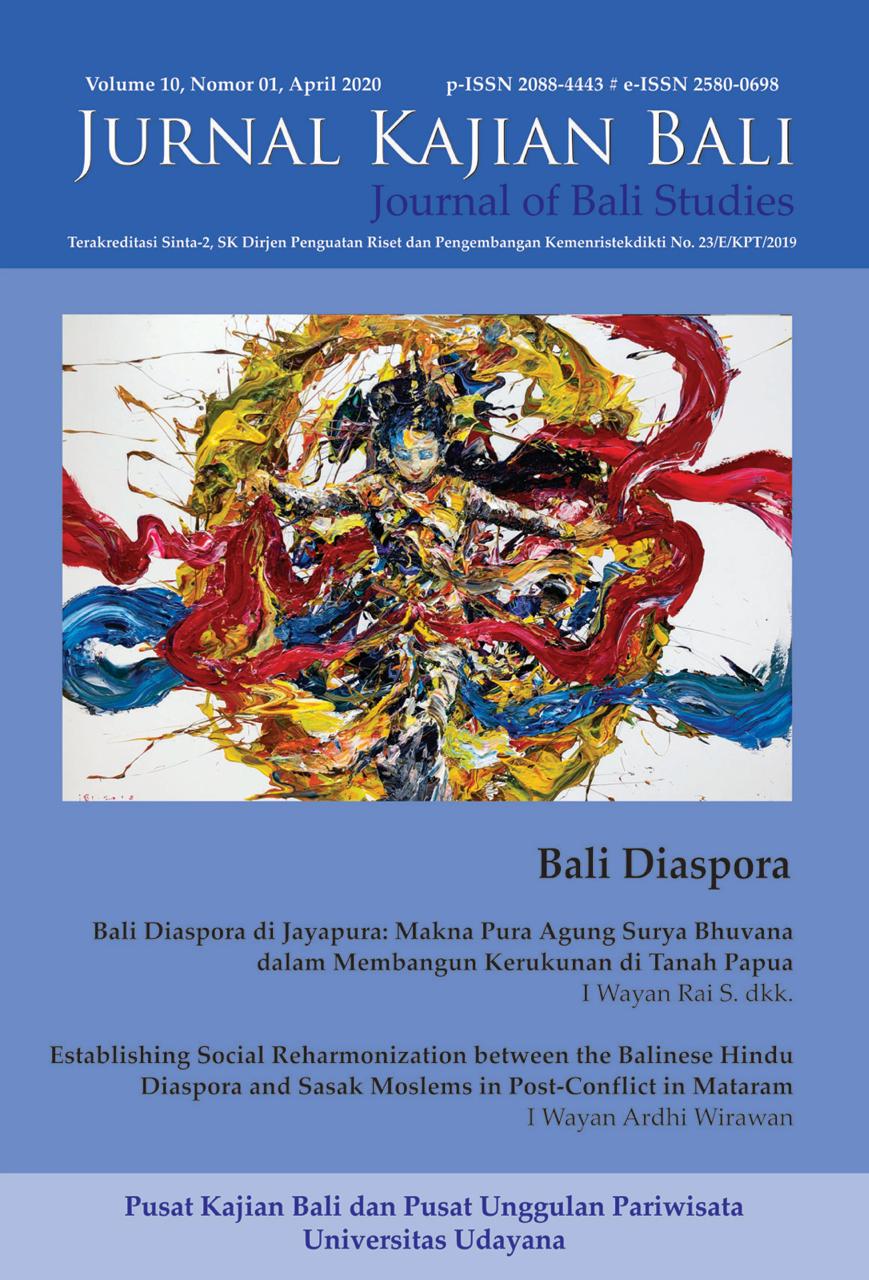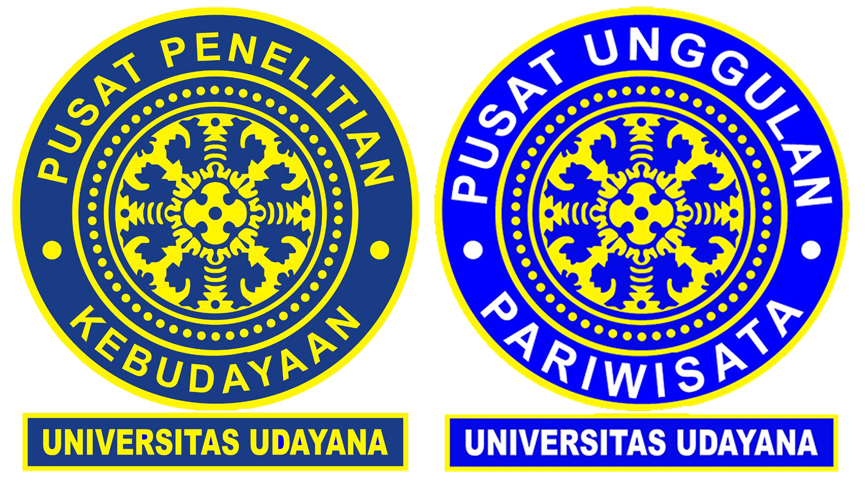Modal Budaya Guru Yoga Lokal Menghadapi Persaingan Global dalam Pariwisata Yoga di Bali
Abstract
Yoga tourism in Bali has been running from the 1980s to the present day, initially created by overseas yoga teachers. In the 2000s, however, local Balinese yoga teachers began to emerge and compete with overseas yoga teachers. This article analyzes the ability of local yoga teachers to compete in the business of yoga tourism against foreign yoga teachers. The analysis focuses on the cultural capital owned by local yoga teachers and the role of that cultural capital in business competition of yoga tourism. Data was collected by literature study, non-participatory observation, in-depth interviews, and surveys. They were nalyzed by habitus theory and the product planning theory. This article concludes that the unique cultural capital possessed by Balinese yoga teachers is a provision for them to face competition in the yoga tourism business which eventually becomes a way for them to preserve that cultural capital.
Keywords: yoga tourism, cultural capital, the uniqueness of Balinese yoga
Downloads
References
Aggarwal, A., Guglani, M., & Goel, R. (2008). Spiritual & Yoga Tourism: A casestudy on experience of Foreign Tourists visiting Rishikesh, India. Conference in Tourism in India-Challenges Ahead. Retrieved from http://dspace.iimk.ac.in/handle/2259/588.
Ariyani, N. I., Demartoto, A., & Zuber, A. (2015). Habitus Pengembangan Desa Wisata Kuwu: Studi Kasus Desa Wisata Kuwu Kecamatan Kradenan Kabupaten Grobogan. Jurnal Analisa Sosiologi, 4(2).
Bhavanani, A. (2017). Yoga in Contemporary India: an Overview. Yoga Life, 48, 1–15.
BPS. (2020). BPS Provinsi Bali. Retrieved from http://bali.bps.go.id/tabel_detail_eng.php?ed=611008&od=11&id=11.
Cakapane. (2012). Sejarah Rsi Markendya. http://cakepane.blogspot.com/2012/12/sejarah-rsi-markadeya.html. Diakses 23 Pebruari 2020, pukul 12.00 Wita.
Dinas Pariwisata Provinsi Bali. (2019). Statistik Wisman tahun 2018. Dinas Pariwisara Provinsi Bali. https://doi.org/10.1017/CBO9781107415324.004.
Lee, K. J., Dunlap, R., & Edwards, M. B. (2014). The Implication of Bourdieu’s Theory of Practice for Leisure Studies. Leisure Sciences, 36(3), 314–323. https://doi.org/10.1080/01490400.2013.857622.
Maddox, C. B. (2015). Studying at the source: Ashtanga yoga tourism and the search for authenticity in Mysore, India. Journal of Tourism and Cultural Change, 13(4), 330–343. https://doi.org/10.1080/14766825.2014.972410.
Mallinson, J. (2012). Early Ha thayoga. Tanpa Tempat dan Nama Penerbit.
Mylonopoulos, D., Moira, P., & Parthenis, S. (2019). Pilgrimages through time and space. The case of Marian Pilgrimages in Greece. International Journal of Religious Tourism and Pilgrimage, 7(4), 97–105.
Nala, Ngurah. (2006). Aksara Bali dalam Usada. Surabaya: Paramita.
Peraturan Daerah Tentang Kepariwisataan Budaya. (2012). In Pemerintah Provinsi Bali.
Ritzer, G., & Smarth, B. (2014). Handbook Teori Sosial. Bandung: Nusa Media.
Seaton, A.V dan M.M. Bennett. (1996). Marketing Tourism Products; Concepts, Issues, Cases. London: Thomson Business Press.
Sirirat, P. (2019). Spiritual tourism as a tool for sustainability: A case study of Nakhon Phanom province, Thailand. International Journal of Religious Tourism and Pilgrimage, 7(3), 97–111.
Sutarya, I. G. (2016). Spiritual Healing dalam Pariwisata Bali : Pengembangan, dan Kontribusi. Udayana.
Sutarya, I. G. (2018). Agen Budaya dan Pemasaran: Peran Ganda Jaringan Perguruan Spiritual dalam Promosi Wisata Spiritual di Bali. Kajian Bali, 08(01).
Trimurti, C. P., & Utama, I. G. B. R. (2019). an Investigation of Tourism Motivation and Tourist Attraction of Tourists To Bali. Jurnal Manajemen Dan Kewirausahaan, 21(2), 130–133. https://doi.org/10.9744/jmk.21.2.130-133.
Udayana, A. A. G. B. (2017). Marginalisasi Ideologi Tri Hita Karana Pada Media Promosi Pariwisata Budaya Di Bali. Mudra Jurnal Seni Budaya, 32(1), 110–122. https://doi.org/10.31091/mudra.v32i1.4.
Utama, I. G. B. R. (2016). Keunikan Budaya dan Keindahan Alam sebagai Citra Destinasi Bali menurut Wisatawan Australia Lanjut Usia. Jurnal Kajian Bali: ISSN: 2088-4443, 06(April), 149–172. Retrieved from http://ojs.unud.ac.id/index.php/kajianbali/article/view/19904.
Utama, I. G. B. R. (2017). Tourism Destination Image of Bali According to European Tourist. 134(Icirad), 27–31. https://doi.org/10.2991/icirad-17.2017.6.
Warren, K. (2017). The Maturing Industry. Wealth, Waste, and Alienation, 3(40), 25–76. https://doi.org/10.2307/j.ctt6wrcrh.8.
World Travel Organization. (2019). International Tourism Highlights International tourism continues to outpace the global economy. 1–24. https://doi.org/https://www.e-unwto.org/doi/pdf/10.18111/9789284421152?download=true.

This work is licensed under a Creative Commons Attribution 4.0 International License.



















